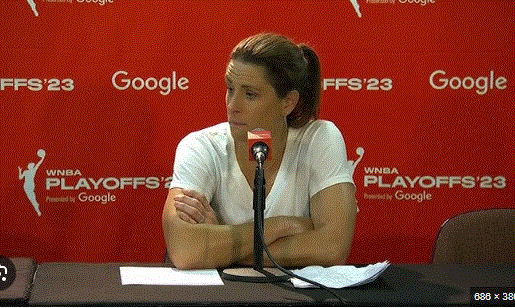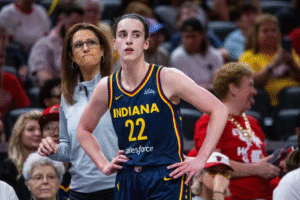
A Deep Dive into the Story of Tyrese Haliburton’s Injury and Caitlin Clark’s Support
1. The Incident: Haliburton’s Injury in Game 7
In a clutch, win-or-go-home Game 7 showdown against the Oklahoma City Thunder, Indiana Pacers star guard Tyrese Haliburton suffered a devastating injury. Early in the game, while attempting to orchestrate an offensive play, Haliburton suddenly fell to the court. Observers could clearly see he was in distress, grabbing at his lower right leg as something within it ruptured or “snapped.” The scene left teammates, coaches—and the Indiana basketball community at large—reeling, as the gravity of a lower-leg injury, especially involving the Achilles tendon, is immediately alarming.

The incident occurred in the first quarter of that critical game, sending shockwaves through the arena. While playoff basketball is known for its intensity, few scenarios are more heartbreaking than watching a talented athlete’s promising season—and potentially career—derailed by such a serious injury on the sport’s grandest stage. There was an eerie hush that fell over fans pandemonium—snap, a dramatic pause, and then collective concern.
2. The Medical Diagnosis: Torn Achilles Confirmed
Within hours of the injury, the Pacers’ front office released a statement providing a clearer picture of the situation. Their medical team had confirmed that Haliburton had indeed suffered a tear to his right Achilles tendon. Such an injury is grave, given the central role the Achilles plays in jumping, starting, stopping, and explosive lower-leg movement—all essential for elite-level basketball.
The confirmation weaves together a few important threads: the image we all saw live, the immediate medical inspection by team doctors, and the public statement issued by Pacers officials. Torn Achilles injuries typically necessitate surgery and months of rehabilitation, altering the course of an athlete’s immediate future.
3. The Surgery and Social Media Revelation
That same Monday—the day after Game 7—Haliburton went under the knife. Surgical teams worked to repair his injured tendon, marking the beginning of a crucial stage in his recovery journey. Later that day, Haliburton posted on Instagram. In his message, he did not mince words. His tone reflected a mix of stunned disbelief and determined hope. He confessed that he was still holed up in a state of shock over the suddenness and severity of the injury.
Yet, amid the emotional tumult, Haliburton expressed a strong resolve. He made a promise to fans: he would push relentlessly to reclaim his physical prime and return as “the best version” of himself. The message came across as a heartfelt appeal to optimism, even in the midst of physical and emotional pain.
4. A Heartfelt Apology to Pacers Fans
In the same social media post, Haliburton offered an apology to Indiana’s devoted fanbase. He acknowledged the shared heartbreak—after all, the organization and the fans had long hoped he would be the cornerstone leading them into NBA glory. The tone was sincere and humble. By saying “I’m so sorry, we don’t deserve this,” he recognized that the team’s journey was cut short in part because of this sudden turn of events. It wasn’t an act of blame—rather, a recognition that he, as the team’s on-court leader, felt a personal responsibility and disappointment.
5. Caitlin Clark Steps In: Icons Supporting Icons
That’s where Caitlin Clark comes into the story. The standout guard for the Indiana Fever, Clark watched Haliburton’s post and responded in her own understated but visible way: black heart emojis. It may sound simple, but on platforms like Instagram, emojis often speak louder than words—especially in tight-knit sports communities. The black hearts symbolized solidarity, sorrow, and empathy—all in a compact graphic.
It’s significant that Clark, another major figure in Indiana sports and someone who moves fluidly through the realm of social media, used that minimalist approach. Her action said, “I’m here, and I care,” without the need for a long statement. In a moment filled with shock and trauma, empathy and unity come through in simple symbols.
6. A Cascade of Support from Across the WNBA
Clark wasn’t alone. Her Indiana Fever teammate Lexie Hull also engaged on Instagram, sending a message through praying hands emojis—classic and unambiguous in their intent. Meanwhile, Aliyah Boston of the Fever penned, “Prayers for a smooth recovery!” Her words were hopeful and heartfelt, acknowledging both Haliburton’s physical pain and the emotional battle ahead.
Even beyond Indiana, camaraderie was evident. Cameron Brink, the center for the Los Angeles Sparks, commented with: “Delayed never denied!!” It’s a reference to the idea that just because his comeback might be postponed doesn’t mean it’s off the table forever. Such supportive messaging from across team lines highlights the interwoven nature of professional sports: competition during the game, solidarity during tough times.
7. The Long Road Ahead: Expected Recovery Timeline
Recovering from a torn Achilles isn’t a quick process. Most rehabilitation timelines range from several months to a year, depending on the individual and the success of their rehab regimen. For Haliburton, the prognosis now includes missing a significant stretch of time—potentially the entire 2025–26 NBA season. Even with modern treatment and aggressive rehab, athlete recovery timelines are cautious. Rushing risks reinjury; patience is essential.
The injury represents a test of physical fortitude, mental resilience, and emotional strength. For a 25‑year‑old playmaker who was poised to build upon a breakthrough season, it’s a devastating twist. The context matters: this wasn’t just any player, in just any game. He was the face of a franchise with serious postseason hopes, playing in a dramatic elimination game.
8. Holistic Support: Team, Teammates, and Community
Haliburton is considerably seasoned compared to rookies or fringe rotation players. Yet, his relative youth shouldn’t diminish the severity of this event. Official team support matters—doctors, trainers, coaches, front office, rehab specialists. But so does personal support: teammates, friends, family.
The emotional messages from Clark, Hull, Boston, and Brink represent the public face of that support network. Club staff will be working behind the scenes, crafting a rehab plan. But the emotional lift—especially from fellow athletes and fans—is a critical pillar. The hiatus will be long, the work arduous, and the uncertainty of return rests at the center of it all.
9. The Broader Context: Indiana’s Sports Ecosystem
There’s an underlying subtext here: the prominence of basketball in Indiana’s cultural landscape. On one hand, you have Tyrese Haliburton as the Pacers’ rising star—expected to lead them to long-overdue playoff success. On the other, Caitlin Clark, a generational talent at the collegiate level who has brought renewed energy to the Fever and to women’s basketball in general.
When these two figures interact—especially in moments of crisis—it’s emblematic of something larger. It’s not just two athletes on social media; it’s the broader narrative of Hoosier basketball interlocking. Indiana has watched generations of legends: Chamberlain, Lue, Miller, etc. Now, Clark has appeared as perhaps the most famous female Indiana basketball player since her college days, and Haliburton as the men’s game’s new heartbeat.
Their exchange of black hearts and emojis carries symbolic weight. It’s a reminder: beyond the business of sport, beyond the box scores, beyond game plans—these are humans. And when tragedy strikes, sometimes a few small digital symbols hold profound communal meaning.
10. Projecting Forward: What Comes Next
Now the horizon stretches weeks, months ahead. Immediately, the next steps include surgery and the start of recovery. Then comes physical therapy, incremental weight-bearing, conditioning, basketball-specific training, and gradually, on-court work. Each step will be carefully calibrated, with input from medical professionals.
Will he return to peak form? That’s the million-dollar question. Some athletes come back equal to or stronger than before—but others struggle. The Achilles tendon heals, but the athlete must regain confidence, explosiveness, lateral agility. Movement patterns feel different. In Haliburton’s case, he is at a pivotal age—25 is still young, and the foundational years remain ahead. His stellar skill set includes elite shooting, playmaking, and decision-making—all less reliant on pure athleticism. So there’s hope.
His public promise to “get right back to being the best version” of himself reflects both personal determination and professional confidence. It doesn’t guarantee a full comeback, but it sets the tone. Fans and analysts alike will watch his progress closely.
11. The Emotional Undertow: Athlete Mindset and Identity
An Achilles tear doesn’t just disrupt the body—it disrupts identity. For athletes, especially stars, the court is their domain. Being sidelined for an extended period can trigger doubt, anxiety, even depression. The mental toll can rival the physical pain.
Haliburton’s candor—acknowledging shock, sharing vulnerability—is a healthy first step. The post helped him process the event and opened space for support. The black hearts, praying emojis, and optimistic quips from colleagues create a support tapestry.
Ahead will come tougher conversations: “How’s the day-to-day rehab going?” “How are you handling minutes off the court?” “What about your sense of purpose and goals?” If answers come with the steady patience reflected in his original statement, then the foundation for long-term recovery is solid.
12. Community Impact: Beyond Haliburton
When any athlete suffers such a public setback, the ripple effects extend. For the Pacers, their plans shift. Will they modify their roster? Adjust their game strategy? Haliburton’s injury forces a recalibration: do they lean on other guards? Change defensive schemes? See more of rotating players or pursue trade/waiver pickups? His absence will directly alter their offensive flow.
Meanwhile, fans across Indiana will experience collective grief. Sports allegiance can be tribal. Losing a star in a sudden, brutal way leaves emotional and experiential emptiness. But the community reaction—holding up signs, social media posts, organized efforts—reinforces the reality that athlete and fan remain partners.
A similar narrative resonates in the feverish fandom around Caitlin Clark and the Fever. Clark’s simple gesture feeds both human empathy and local pride. “This is how we rally,” her action says to the rest of the state.
13. Lessons Learned: The Fragility of Athletic Fortune
In athletics, moments of triumph and disaster can occur in the blink of an eye. One elite drive, one sudden movement—and a star season can derail. Haliburton’s plight embodies both the excitement and risk of sport.
But it also offers lessons. Physiology matters: tendons have limits. Preparation matters: warm-ups, conditioning, load management. Community matters: recovery is not solitary. Emotional health matters: identity and athletes’ mental worlds demand care.
In that sense, this incident becomes more than a headline. It’s a case study in modern professional sports: peak physical performance, vulnerability, crisis, and community response.
14. The Final Word: Hope Amid Heartbreak
In essence, what began as a hopeful Game 7 contest ended in tragedy for Haliburton but created a moment of sporting solidarity. The goalie fell, but the players—his peers—stood up. They sent messages. They connected.
He hurt. They cared.
He lamented: “I’m sorry.” They replied: “We’re with you.”
He faced uncertainty. They promised patience.
Across time zones and fields, across teams and courts, that message rings clear: sport may be transient, but support can endure.
Summary of Key Points
- Game 7 Injury: Achilles tear in first quarter left Haliburton on the floor, visibly in pain.
- Medical Confirmation: Torn right Achilles tendon required immediate surgery.
- Social Media Statement: Shock, apology to fans, vow to “get back to being the best version.”
- Caitlin Clark’s Reaction: Black-heart emojis—silent yet powerful symbol of support.
- Broader WNBA Response: Multiple teammates and players expressed solidarity with prayers and encouragement.
- Recovery Outlook: Months away from action, likely missing 2025–26 season.
- Emotional and Mental Impact: Rehabilitation will test Haliburton’s resilience, identity, and mental health.
- Community and Franchise Response: Pacers adjust their strategy, fans engage in emotional journeys.
- Human Element: In tune with global empathy, showing that behind every athlete is a person.
- Forward Momentum: Though recovery is long, the foundation of medical, emotional, and professional support offers hope.
Leave a Reply